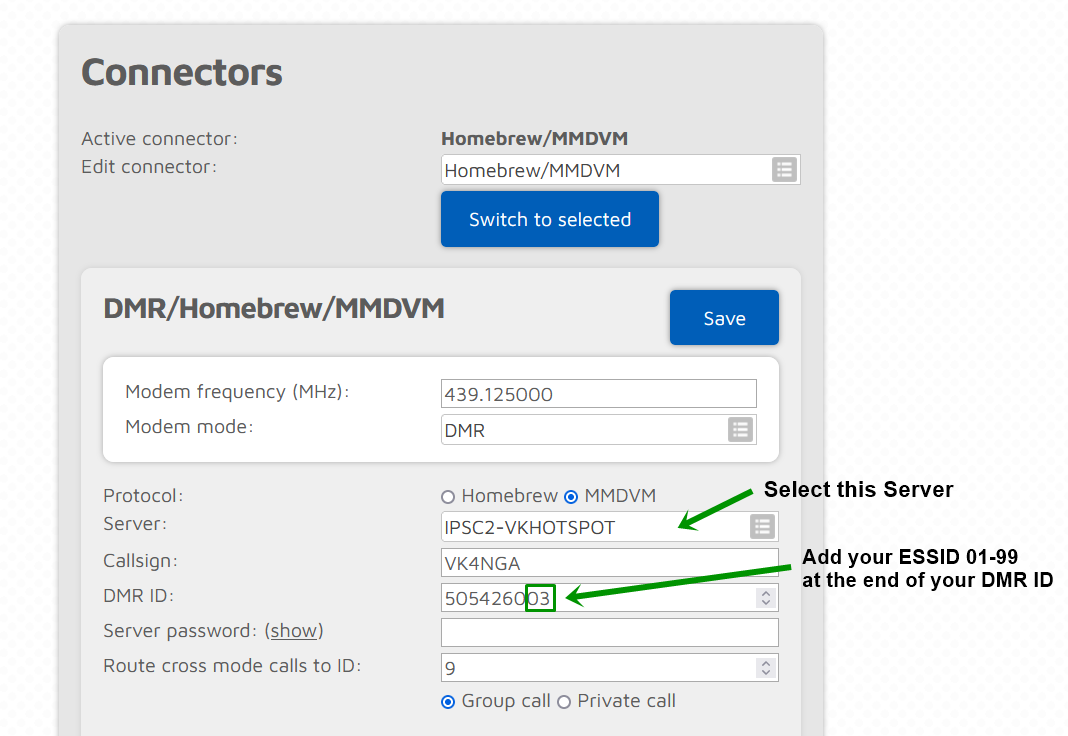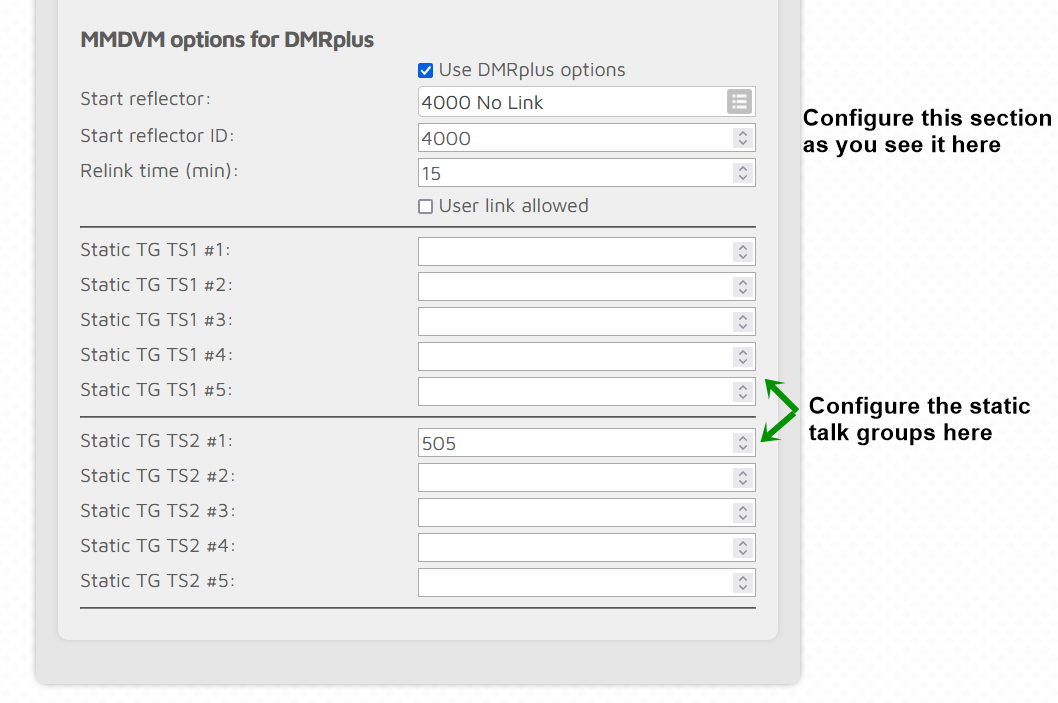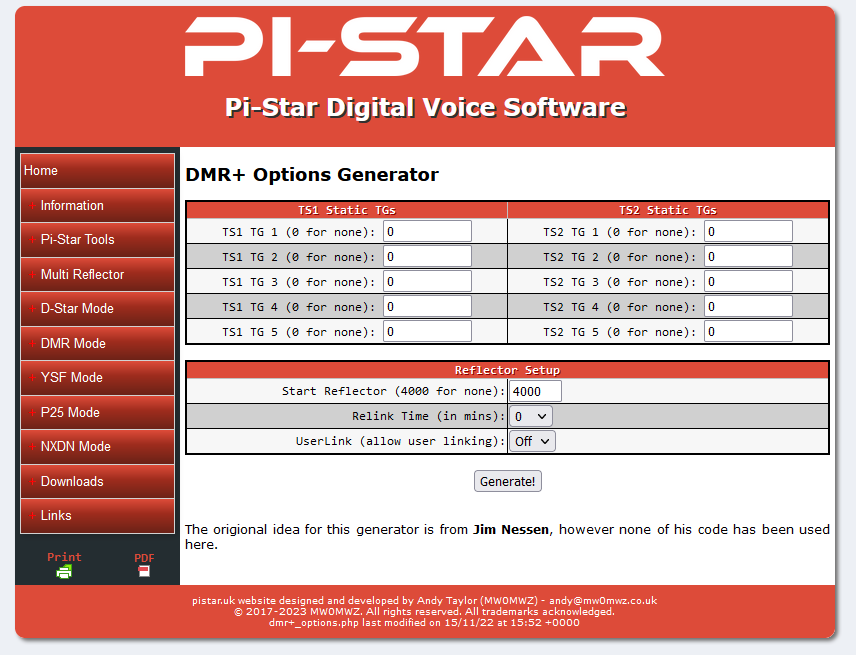View the Hotspot Dashboard Real-Time Data: http://hot.vkdmr.com
YOU CAN CONNECT most Pi-Star based hotspots and any openSPOT to the network.
Other Methods of Connecting
Pi-Star Hotspot Configurations
Below is how to configure Pi-Star for the VK DMR Network.

After the page refreshes it will look like this.

openSPOT Hotspot Configurations
Pictured below is the Connector from an openSPOT 2. All openSPOT’s run similar connector layouts
“DMR Options” Configurations
For Pi-Star users click the image to go to the options generator, for clarifications of the options, please read the explainations below.
Options Explained
Static and Dynamic TG’s
You need to understand how your hotspot behaves with “static” and “dynamic” groups. If you have a talk group set as “static” and traffic appears on that talk group, your hotspot will be active on that talk group.
If you want to add, say TG505 as static, you would change the “DMR Options” in DMR Configurations as follows:
Options= StartRef=4000;RelinkTime=15;UserLink=1;TS1_1=9;TS2_1=505;
As you add more static talk groups you are going to find it more difficult to follow a conversation or hold a QSO if more than one of your static talk groups are active.
This is where dynamic talk groups come in. If you set your hotspot up with no static talk groups, when you key up a talk group it remains active for a period of time. The current hold timer is 15 minutes if the talk group is not set as static in your DMR options.
If you don’t want to set any talk groups as Static TG’s use:
Options= StartRef=4000;RelinkTime=15;UserLink=1;TS1_1=9;
With no statics set, if you transmit on, for example, TG3802, it will be dynamic and disappear after 5 seconds, but if you look at the hotspot dashboard you’ll see TG3802 hold timer counting down from 15 minutes. That means your hotspot will hear traffic on that TG until the timer lapses.
Simplex hotspots behave very differently to duplex hotspots with regards to static talk groups. The best advice for simplex hotspot users is to set TG505 as a static on time slot 2 and have no other statics set on time slot 1.
Although Simplex hotspots use time slot 2 only – the hotspot does the conversion to the other TG and time slot as required, we recommend that you always program your radio with the appropriate time slot associated with the talk group.
A great way to understand this is by viewing the hotspot dashboard.
Network Timers and Your Hotspot
After you transmit on TG505 if you watch the hotspot dashboard you’ll see that there’s a timer counting down from 15 seconds, that timer is set by the network. If you want to QSY from TG505 to a time slot 1 talk group, and are using a simplex hotspot running Pi-Star, with TG505 set as a static talk group, you’ll have to wait for the timer to drop to zero before you PTT the new talk group. If you don’t wait, and QSY to another talk group on your radio, then PTT you’ll still come up on TG505. The reason is while the timer is active your hotspot is kind of “Glued” to TG505.
If you have a Duplex hotspot with TG505 set as a static then you can QSY from TG505 at any time, even if there is traffic on TG505.
The network timer on time slot 1 talk groups is 5 seconds, as those talk groups are UA.
Duplex or Simplex Hotspot – Which is Better for the VK DMR Network?
Whilst the Working Group team are not biased one way or the other, there are some things to consider.
If you are going to use your hotspot for other modes as well then a simplex hotspot is easier to configure – plus much easier to understand how it works, especially if you are new to hotspots/DMR/digital voice modes.
If you are only using the VK DMR Network then a duplex hotspot has some advantages. Because it has two radio chips (simplex has one) Pi-star allows it to RX and TX on both time slots simultaneously, just like the network repeaters. For example this means if TG505 has traffic you can at the same time TX/QSO on a time slot 1 talk group.
If you have a Duplex hotspot with TG505 set as a static then you can QSY from TG505 at any time, even if there is traffic on TG505.
To further explain it, if you had 2 radios running, one on TG505 (time slot 2) and the other on a time slot 1 talk group, you could chat on the time slot 1 talk group, and if someone comes up on TG505 you’d here them as well on the other radio, so 2 QSO’s can occur simultaneously.
The openSPOT range of hotspots are all simplex.
For More Network Information
Click the image below: stats.vkdmr.com Kindly provided by Matt VK2FLY.



